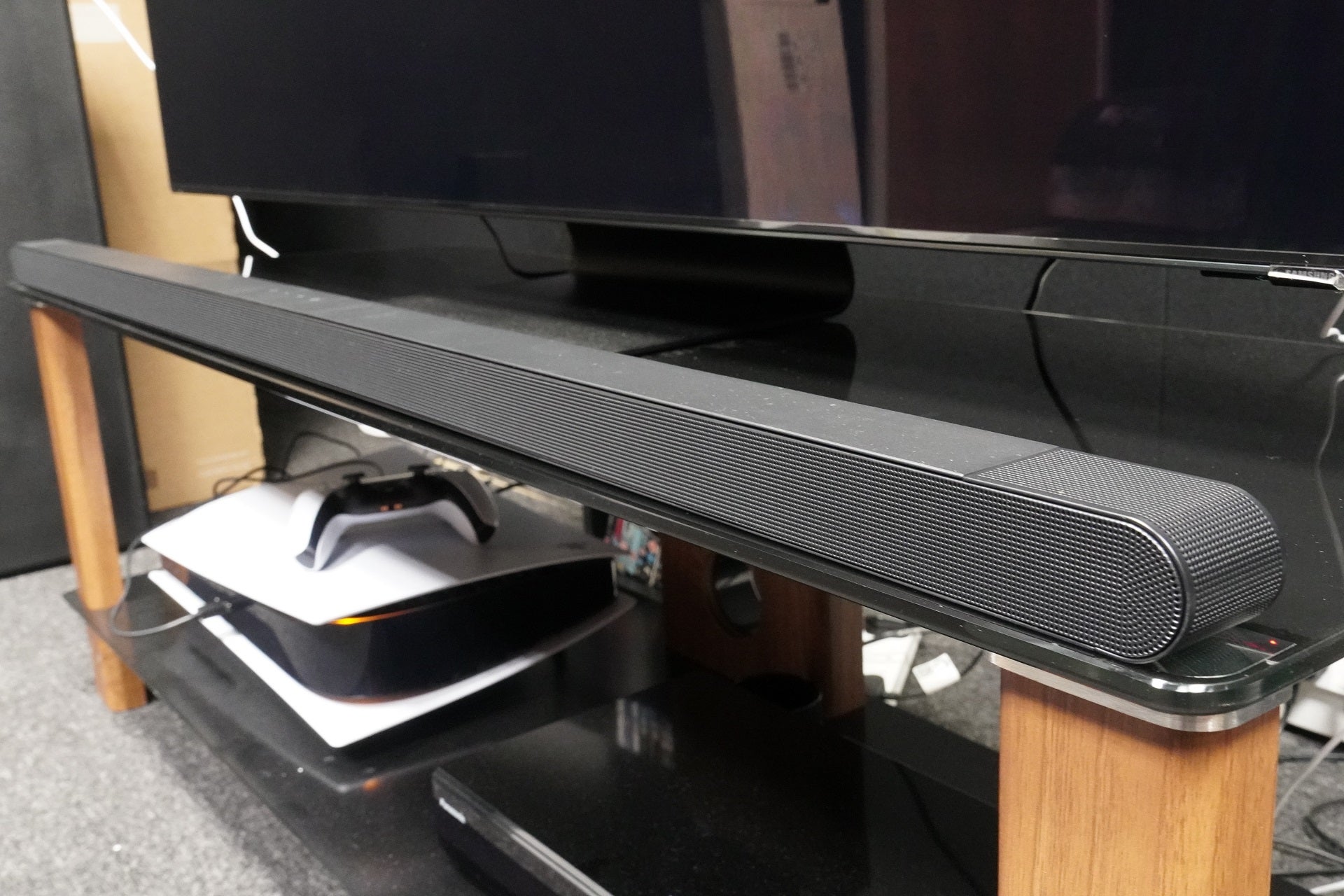Verdict
Samsung’s slim-profile soundbar offers plenty of sonic fireworks, especially with Dolby Atmos, but the lack of a mini-HDMI cable and awkward LED indicators are unnecessary complications.
Pros
- Wide, tall and spacious performance
- Thin, space-saving design
- Powerful subwoofer
Cons
- Inconvenient LED menu
- No mini-HDMI cable provided
- Audio cuts out in DTS Virtual:X mode
Availability
- UKRRP: £649
- USARRP: $999
- EuropeRRP: €749
- CanadaRRP: CA$999
- AustraliaRRP: AU$999
Introduction
Recent trends in the soundbar market have steered towards compact bars, but have you ever given consideration to a slim one? Samsung believes it’s onto something with its ultra-thin HW-S800B.
You might presume that the idea of a thin soundbar is a gimmick, but there is sense guiding Samsung’s design. A thinner soundbar doesn’t take up as much space or weigh as much as a full-sized variant when wall-mounted, making for an easier install and less distracting presence.
The question is – does such a thin profile mean the performance takes a hit?
Design
- Slim, space-saving design
- Inconvenient LED menu
- Mini-HDMI cable not included
I imagine Samsung’s Audio Labs felt it wanted a challenge with the HW-S800B. They’ve managed to fit the various speakers into an enclosure with a depth of 39.9mm and a height of 38mm. By comparison, Samsung’s HW-Q800B is 120mm deep and 60mm tall – the S800B is wafer thin.
Like the rest of Samsung’s 2022 soundbar line-up, the S800B’s appearance is discreet. It’s another grey tone finish, its entire front covered by an unflattering grille. At either end of the speaker are the upfiring drivers that fire audio towards the ceiling.
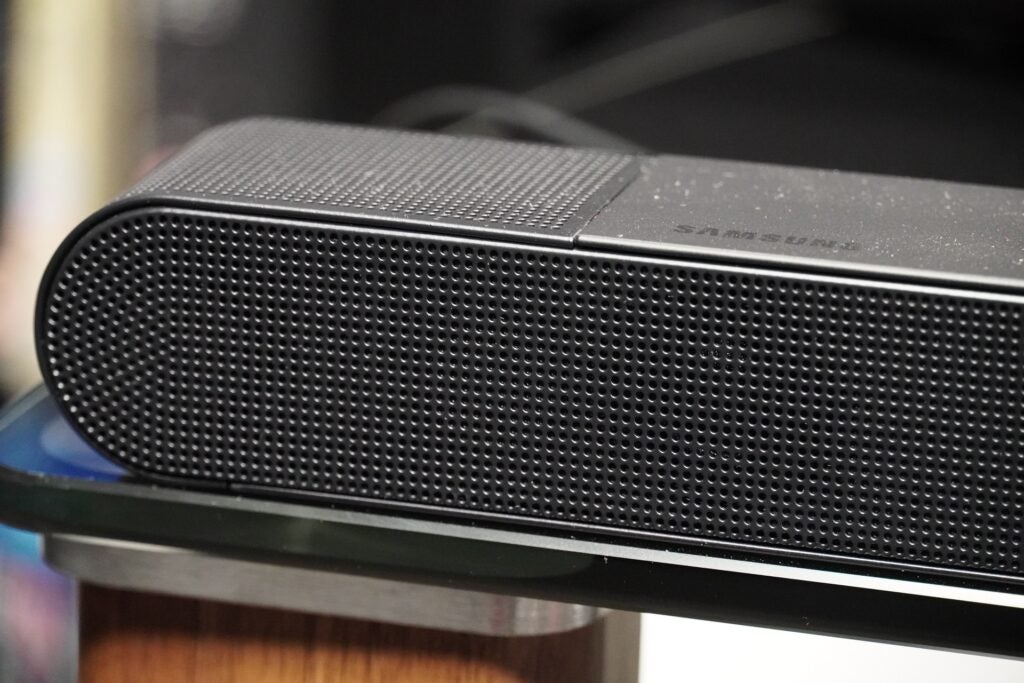
There’s one connection – a mini-HDMI ARC out to a TV – and it requires a mini-HDMI cable.
Unhelpfully, neither a mini-HDMI cable nor adapter is provided, which is an oversight. Mini HDMI ports aren’t common, and there’s no optical digital port either.
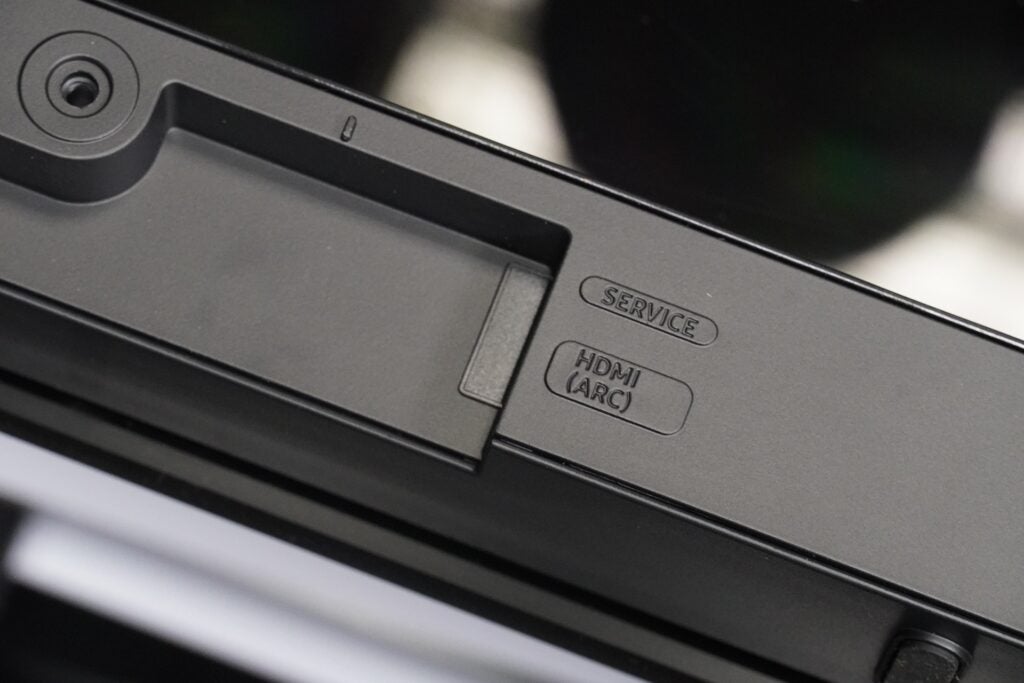
On top of the unit are buttons for power, volume and the S800B’s microphones. The thin remote features volume rockers for the main unit and subwoofer, buttons for customising audio, inputs and mute buttons, along with a D-pad to navigate the S800B’s menus and more besides. It’s simple, easy to use and most of all, responsive.
An area of consternation I have is Samsung’s persistence with its LED indicator. It uses five LED dots that flash and change colour (red, cyan, green or white) depending on the soundbar’s state.
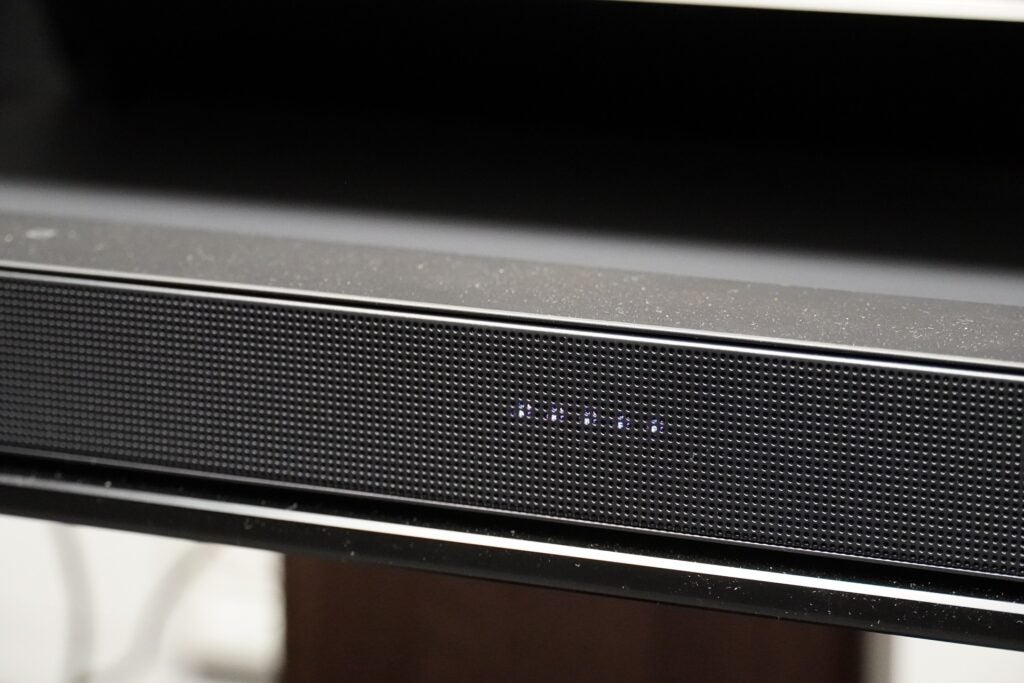
Not only do I find it tricky to make sense of what the dots mean without consulting the manual, they’re barely noticeable at normal viewing distances. Soundbars like Polk’s MagniFi Mini AX make a better attempt with a screen that can be concealed and not affect the overall design.
The accompanying subwoofer is smaller and squatter than Samsung’s usual efforts, and it shares the main unit’s inconspicuous appearance. As there’s no reflex port, Samsung employs a custom passive radiator instead. That should also offer more flexible placement options.
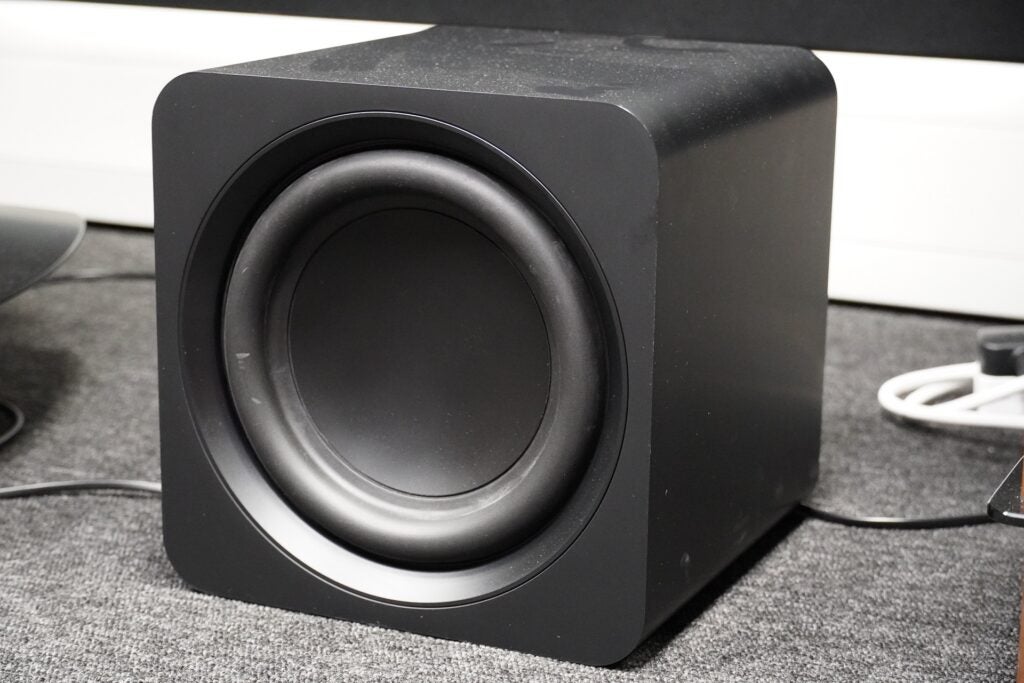
Features
- Hands-free Alexa
- SpaceFit calibration for calibrating audio
- Support for Wireless Dolby Atmos
The HW-S800B packs ten speakers for 3.1.2-channel set-up. This includes a centre channel for dialogue and two upfiring speakers for immersive audio, while the wireless subwoofer features a long-excursion 6.5-inch woofer. That’s smaller than usual, but Samsung is convinced it can replicate the performance of a larger woofer unit.
Though Samsung lists DTS:X on the S800B’s product page, that appears to be erroneous. DTS Virtual:X is supported, which upscales DTS tracks into ‘3D’ through digital processing.
Dolby 5.1, Dolby Digital+, Dolby Atmos, DTS 5.1 and 2-channel LPCM are supported. There’s no Dolby TrueHD compatibility as the S800B’s HDMI port is ARC and not the enhanced version to pass-through higher-quality audio.
Like the HW-Q800B, this S-series bar uses the built-in microphones to equalise the bar’s performance to compensate for room acoustics with Samsung’s SpaceFit calibration.
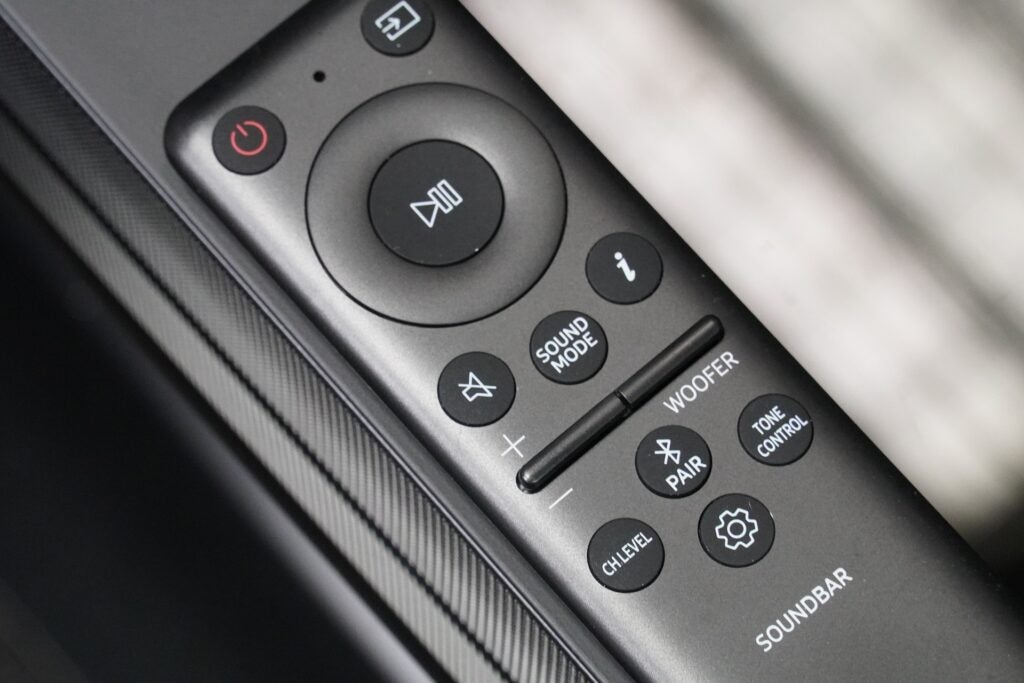
Other tech includes Samsung’s Active Voice Amplifier (AVA) which automatically lifts the volume of dialogue above distracting noises in a room. Adaptive Sound uses artificial intelligence to enhance audio, emphasising dialogue with news and films, or making the crowd noise bigger in sports. Other audio modes include Standard, Surround, Game and the above-mentioned DTS Virtual:X.
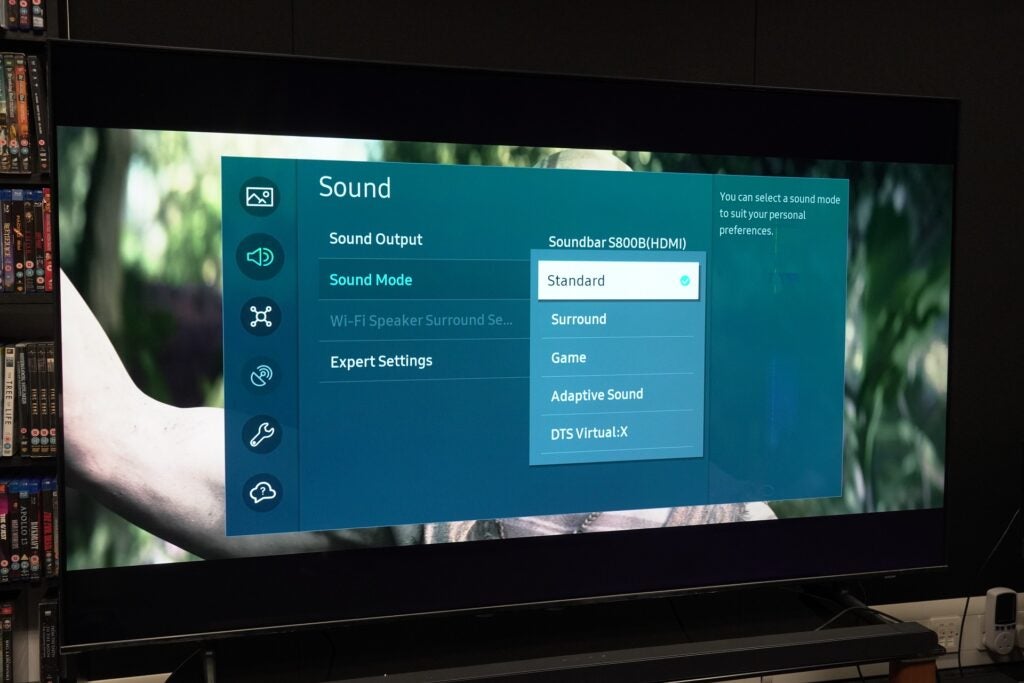
There is Hi-res audio decoding, so listening to lossless music is on the table. It can also decode AAC, MP3, FLAC, ALAC, WAV, OGG and AIFF files, although as the USB port is service only, you’ll have to rely on Wi-Fi for playback of higher quality tracks.
Wi-Fi and Bluetooth are presented (Bluetooth at SBC quality). Chromecast isn’t available but AirPlay 2 is, and Wi-Fi also allows for Spotify Connect integration.
Wireless Atmos means the HW-S800B can receive an Atmos signal without a physical cable. It’s possible to stream Atmos content wirelessly from Tidal and Netflix.
The SmartThings app provides control over the soundbar’s operation, changing audio settings and EQ for the bar and subwoofer. Spotify Connect and Alexa can be integrated – Alexa is built-in and hands-free; however, the assistant has proved unresponsive thus far.
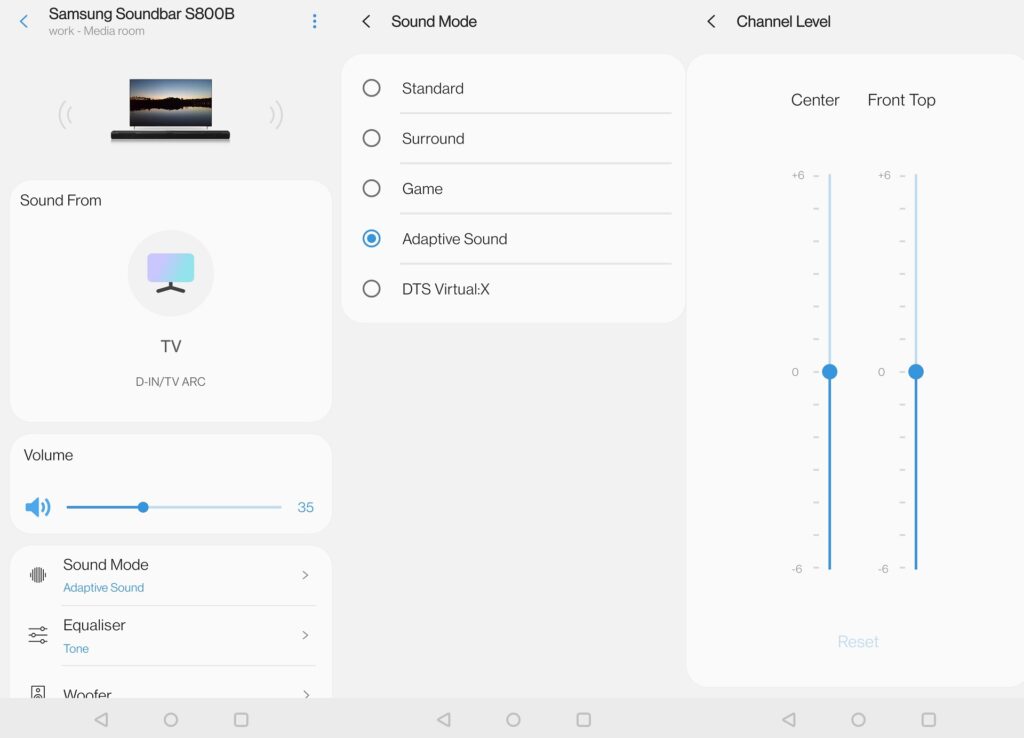
Sound Quality
- Expansive Atmos performance
- Dynamic and energetic sound
- Powerful subwoofer
You would not think the Samsung HW-S800B to be as slim as it is once you’ve heard it. Deepwater Horizon (Atmos) is an intense, expansive and dynamic experience. Thanks to those built-in upfiring speakers, the width and height of its sound easily reaches above and beyond the Samsung BU800 Crystal UHD and QN95B Neo QLED TV we connected it to.
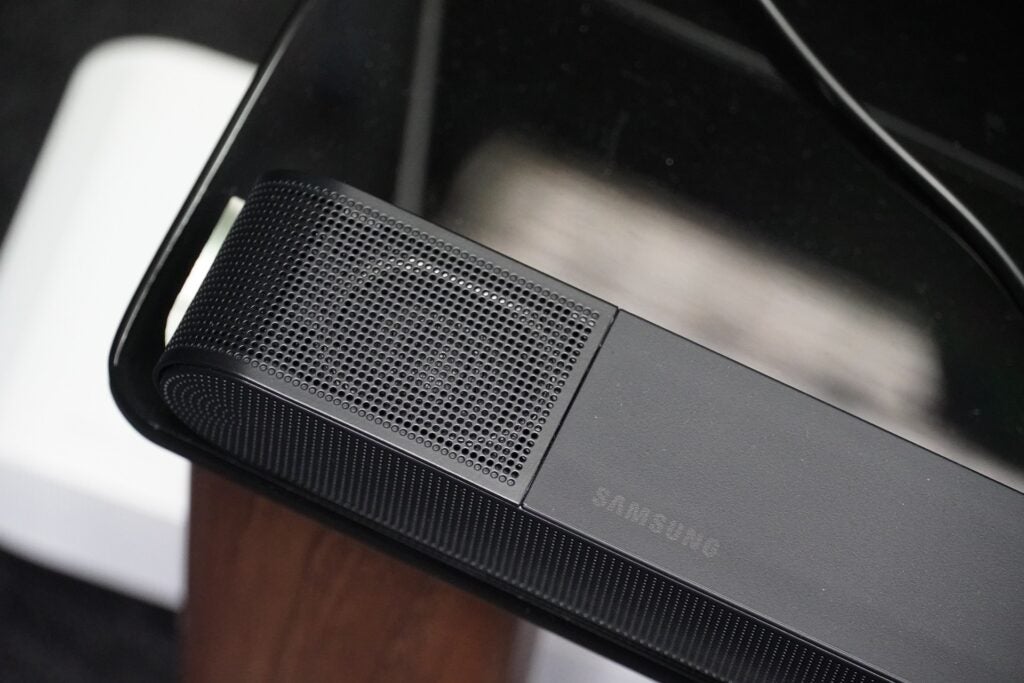
Either end of the frequency range is treated with care. As the flow pipes on the oil rig buckle under pressure, the sound of debris smashing windows has a crisp sharpness, while the creaks and groans of the pipes are given weight by the subwoofer; the sub-bass of the explosions as they rip through the rig is well-controlled. As the torrent of mud flows upwards through the pipe the bar describes it as a fearsome roar – there is power and energy to the S800B that gives the film’s soundtrack heft and impact.
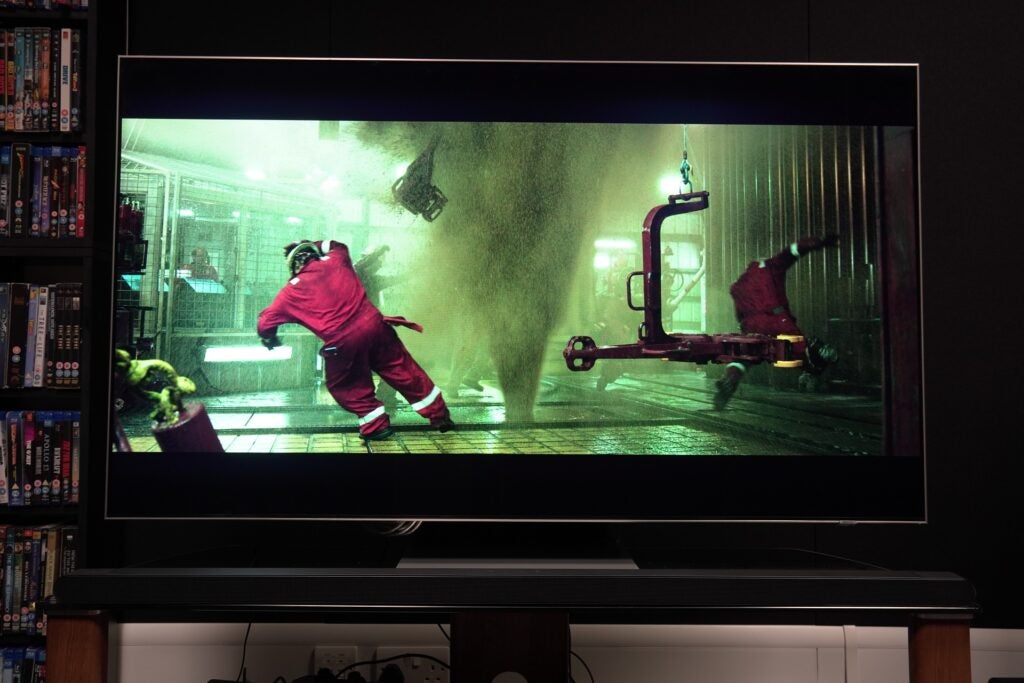
When called upon to be dynamic, there’s plenty of slam and intensity to jump scares. And its sense of height convinces, though the issue with a front-heavy soundstage is that there’s no surround speakers to create the immersive wraparound effect for ‘true’ Dolby Atmos (the S800B is compatible with the SWA-9500S rear speaker kit).
Nevertheless, steering and placement of effects is clear as the alarms go off on the Deepwater and debris flies across the screen, the effects are heard above and to the sides of the TV’s frame.
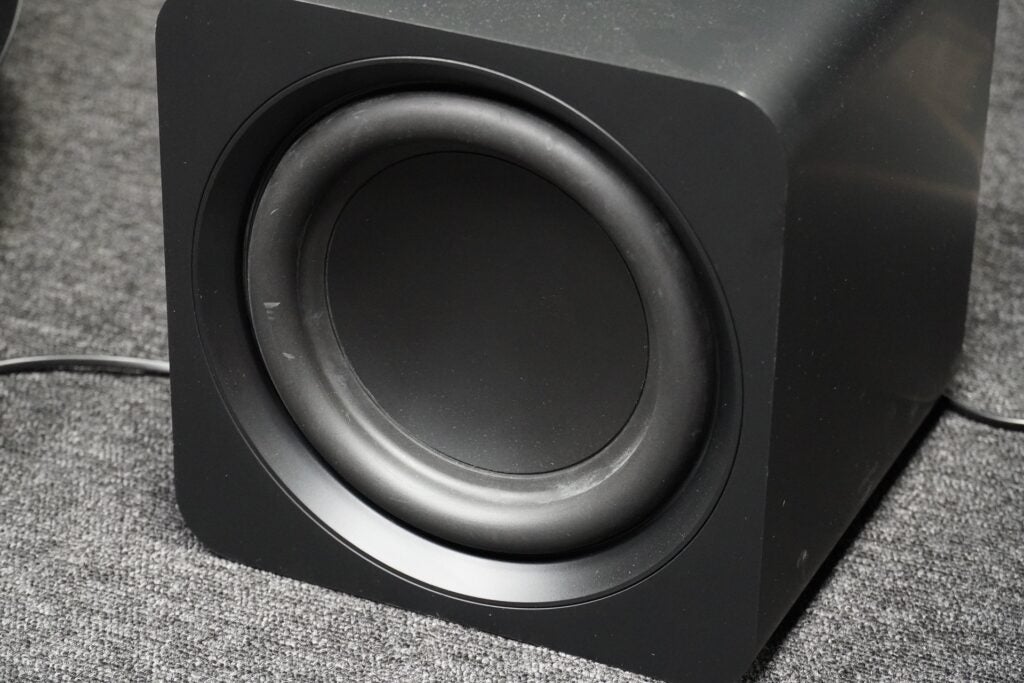
The subwoofer is powerful for its size but doesn’t overreach with Blade Runner 2049’s dynamic soundtrack. It’s well integrated within the frequency range, the shifts from loud to quiet and vice versa are assured, the subwoofer hits the low notes of opening scenes without distortion. The fight between K and Sapper Morton features savage hits and the S800B lays them on with a painful sounding intensity.

Detail is good, though it lacks the subtlety of a ‘bigger’ bar like the HW-Q800B. For instance, in The Force Awakens (Atmos) the sound of the sand as it falls to the ground after a missile from a Tie Fighter rocks the surface of Jakku isn’t as finely detailed as I recalled from the Q800B.
Then there are moments in Blade Runner 2049 where the S800B’s sense of detail is too amplified – but there are instances where it works. Where K meets Manette in an outdoor restaurant area, the hustle and bustle of environment makes the scene crackle with atmosphere. As the scene’s focus shifts to dialogue, the presence of the rain in the background maintains the atmosphere and immersion.
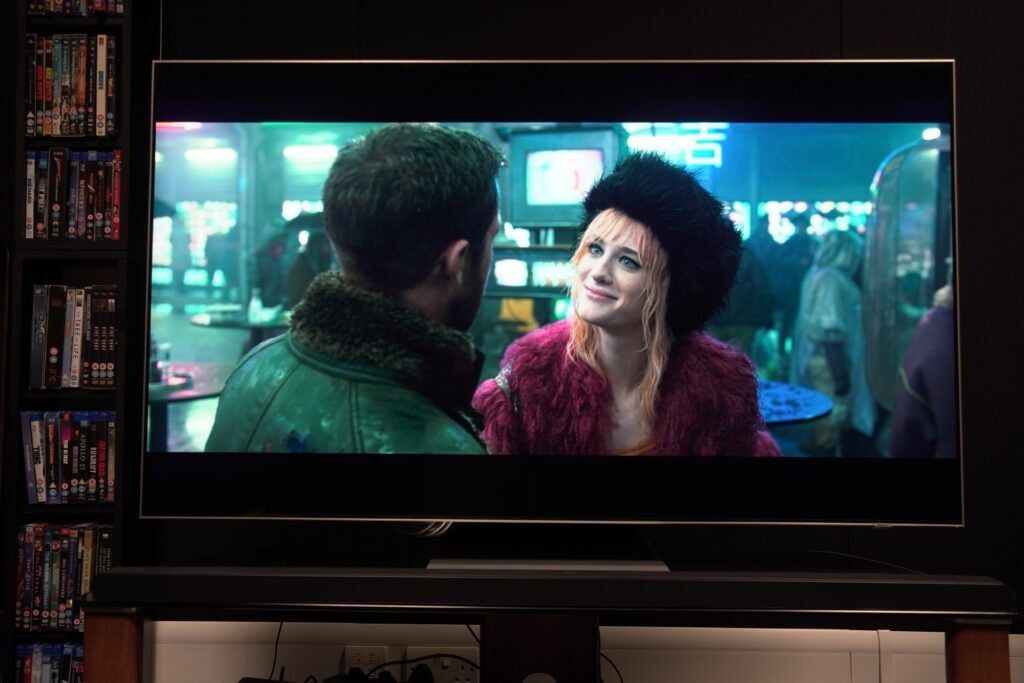
Dialogue is dealt with confidence thanks to the centre channel. From the southern accents in Deepwater Horizon (including John Malkovich’s near-comic delivery) to those in the Disney+ drama The Bear, the S800B calls upon sufficient clarity, tone and character, as well as a dynamism to voices that make it sound like a real conversation is being had. The Voice Enhancement raises voices but also lifts background effects, spiking the treble and introducing sibilant tones.
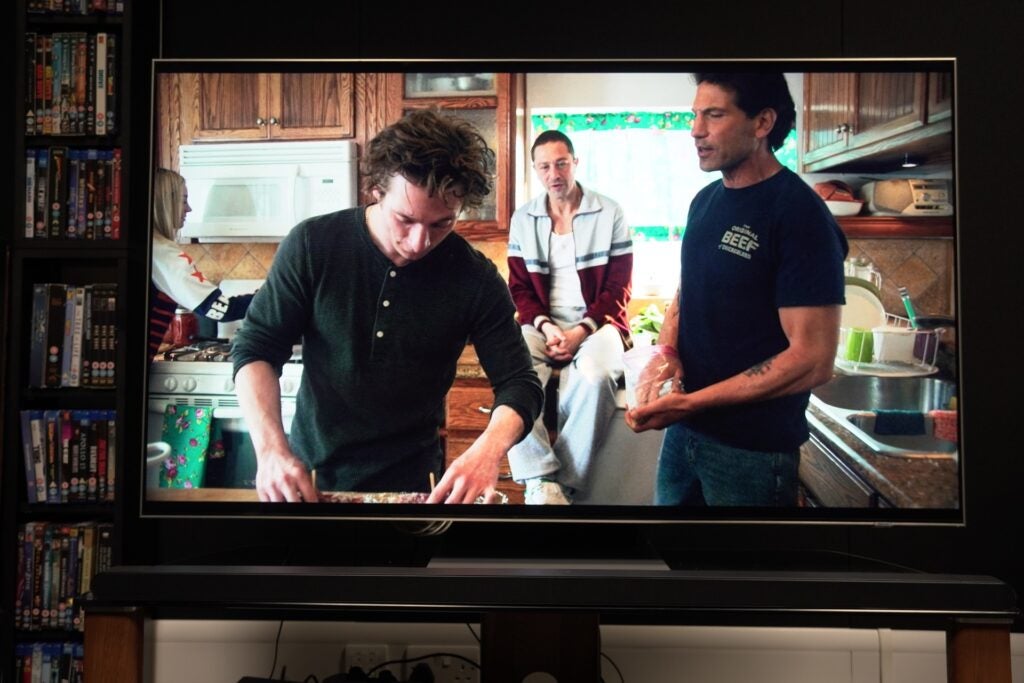
With a Q Symphony compatible TV, I can hear a crisper tone with effects planted on the screen itself. Having tried this with Samsung TVs that support Q Symphony (QN95B) and the ‘Lite’ version (BU8000), the effect on both is similar, with more depth as effects sit on the screen and the soundbar projects into a room. Suffice to say with a Q Symphony compatible TV, there’s even more dimensionality to the sound.
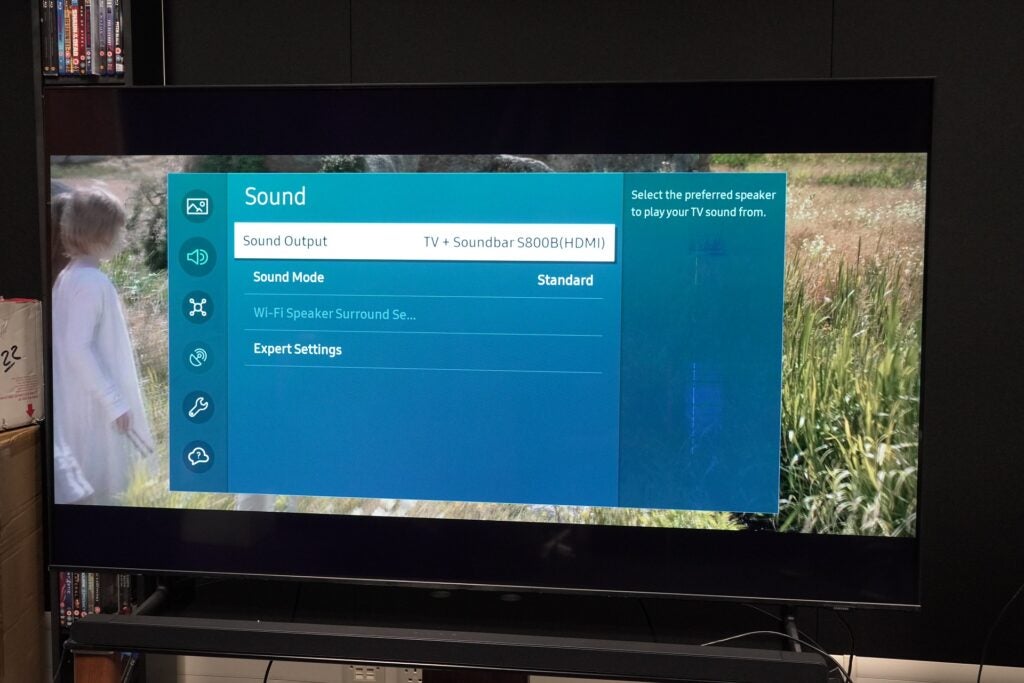
With DTS tracks on E.T or Backdraft, the S800B is a less intense experience, and trying DTS Virtual:X caused the audio would drop out completely on some occasions.
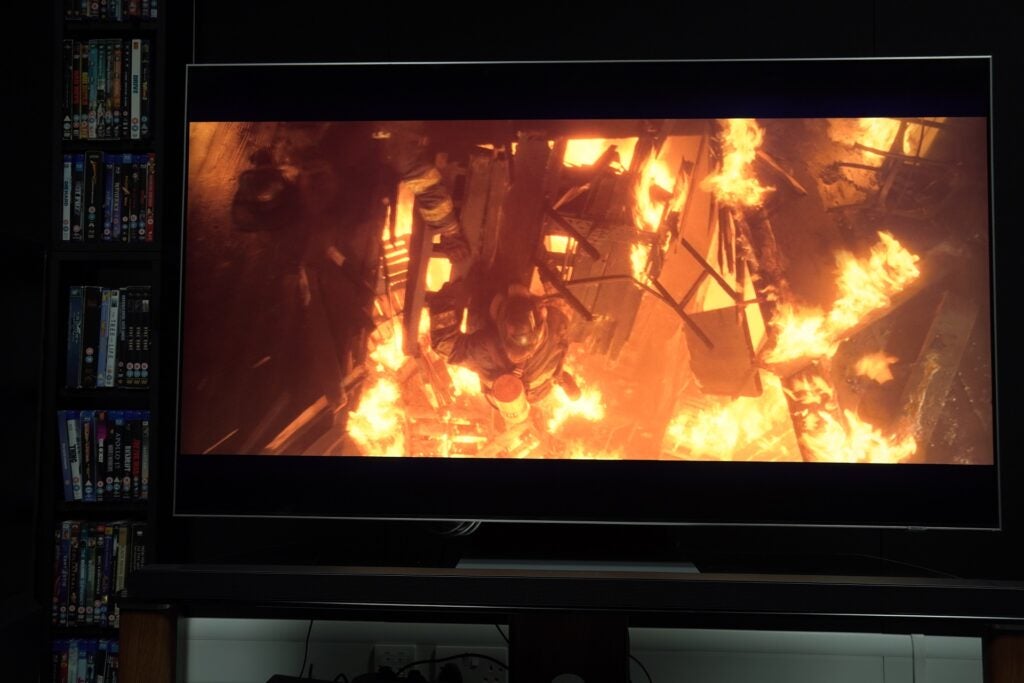
There’s no music mode for Bluetooth playback but the S800B sounds balanced enough: good with voices, solid levels of clarity and some meaty bass in Kainalu’s Folds like Origami. It lacks sharpness and dynamism, and a comparison of tracks over Bluetooth and Spotify Connect shows the latter is clearer, more dynamic, and strikes a more natural tone.
Latest deals
Should you buy it?
If you want a slim soundbar that packs a full-sized sound: An issue with some compact soundbars that they struggle producing a sense of height and projecting sounds out into a room. That’s less of an issue for the S800B.
You’ve got a 4K Blu-ray player: The lack of eARC isn’t a big loss if you get your content from streaming services, but home cinema fans will find that omission an inconvenience, along with the lack of DTS:X.
Final Thoughts
The Samsung HW-S800B is a rollicking effort for a soundbar of its profile. It delivers a sound that’s expansive and tall, a persuasive sense of dynamism, plus plenty of energy and low frequency heft.
Its slim profile takes up less space on a piece of furniture or wall-mounted, and features such as wireless Atmos and Q Symphony offer more seamless integration with compatible TVs.
The LED menu system is puzzling, not convenient or particularly helpful. The lack of a mini-HDMI cable is a big omission and I encountered issues with its DTS Virtual:X too. Depending on where you shop, the HW-Q800B and Q700B models are less expensive, the former around the same price, and both, I’d say, are better.
This is an impressive bar, nonetheless. It’ll fill a niche for those who need a bar that saves some space but still offers an expansive and immersive audio.
How we test
We test every soundbar we review thoroughly over an extended period of time. We use industry standard tests to compare features properly. We’ll always tell you what we find. We never, ever, accept money to review a product.
Find out more about how we test in our ethics policy.
FAQs
There’s no native support for DTS:X on the S800B soundbar but it does support DTS Virtual:X which upscales DTS tracks into 3D immersive sound via digital processing.
Sustainability
Trusted Reviews’ holds the fact that global warming is not a myth as a core value and will continuously endeavour to help protect our planet from harm in its business practices.
As part of this mission, whenever we review a product we send the company a series of questions to help us gauge and make transparent the impact the device has on the environment.
We currently haven’t received answers to the questions on this product, but will update this page the moment we do. You can see a detailed breakdown of the questions we ask and why in our sustainability info page.
Jargon buster
Alexa
Amazon’s smart voice assistant
Dolby Atmos
Dolby Atmos is an object-based audio format. It expands on 5.1 and 7.1 soundtracks by adding overhead channels. Sounds are referred to as “audio objects”, of which there can be up to 128 audio channels, and these ‘objects’ can be accurately positioned within a 3D soundscape. This allows soundtracks that support the technology to place sounds above and around the listener with compatible kit.



















